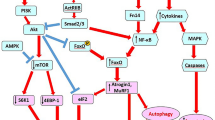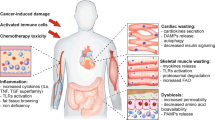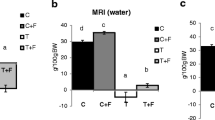Abstract
Cancer cachexia is a complex and multifaceted disease state characterized by fatigue, weakness, and loss of skeletal muscle and adipose tissue. Recently, the profound negative effects of cancer cachexia on cardiac tissue draw much attention, which is likely to contribute to mortality in tumor-bearing animals. The mechanism of cardiac remodeling is not so clear and involved with a series of molecular alterations. In cancer cachexia model, progressive loss of left ventricular mass and decrease in myocardial function is observed and cardiac autonomic functions are altered. Levels of several emerging cardiovascular neurohormones are found elevating in patients with cancer, but it is still controversial whether the changes could reflect the heart injury accurately. The remedy for cardiac remodeling has been explored. It is showed that exercise can modulate signaling pathways activated by wasting cytokines and impact on the resulting outcomes on heart adaptation. Some drugs, such as bisoprolol, spironolactone, perindopril, tandospirone, and simvastatin, can mitigate adverse effects of the tumor on the heart and prolong survival.
Similar content being viewed by others
References
von Haehling S, Anker SD (2014) Prevalence, incidence and clinical impact of cachexia: facts and numbers-update 2014. J Cachexia Sarcopenia Muscle 5:261–263
Shum AM, Fung DC, Corley SM, McGill MC, Bentley N, Tan TC, Wilkins MR, Polly P (2015) Cardiac and skeletal muscles show molecularly distinct responses to cancer cachexia. Physiolgenomics, Physiol Genomics, p. 00128.2014
Springer J, Tschirner A, Haghikia A, von Haehling S, Lal H, Grzesiak A, Kaschina E, Palus S, Potsch M, von Websky K, Hocher B, Latouche C, Jaisser F, Morawietz L, Coats AJ, Beadle J, Argiles JM, Thum T, Foldes G, Doehner W, Hilfiker-Kleiner D, Force T, Anker SD (2014) Prevention of liver cancer cachexia-induced cardiac wasting and heart failure. Eur Heart J 35:932–941
Stewart GD, Skipworth RJ, Fearon KC (2006) Cancer cachexia and fatigue. Clin Med 6:140–143
MacDonald N, Easson AM, Mazurak VC, Dunn GP, Baracos VE (2003) Understanding and managing cancer cachexia. J Am Coll Surg 197:143–161
Ebner N, Steinbeck L, Doehner W, Anker SD, von Haehling S (2014) Highlights from the 7th cachexia conference: muscle wasting pathophysiological detection and novel treatment strategies. J Cachexia Sarcopenia Muscle 5:27–34
Yoshida T, Delafontaine P (2015) Mechanisms of cachexia in chronic disease states. Am J Med Sci. 350(4):250–256
Das UN (2012) Can cancer cachexia be prevented/treated? Nutrition 28:844–848
Lokireddy S, Wijesoma IW, Bonala S, Wei M, Sze SK, McFarlane C, Kambadur R, Sharma M (2012) Myostatin is a novel tumoral factor that induces cancer cachexia. Biochem J 446:23–36
Mondello P, Lacquaniti A, Mondello S, Bolignano D, Pitini V, Aloisi C, Buemi M (2014) Emerging markers of cachexia predict survival in cancer patients. BMC Cancer 14:828
Das SK, Hoefler G (2013) The role of triglyceride lipases in cancer associated cachexia. Trends Mol Med 19:292–301
Mendes MC, Pimentel GD, Costa FO, Carvalheira JB (2015) Molecular and neuroendocrine mechanisms of cancer cachexia. J Endocrinol 226:R29–R43
Mondello P, Mian M, Aloisi C, Fama F, Mondello S, Pitini V (2015) Cancer cachexia syndrome: pathogenesis, diagnosis, and new therapeutic options. Nutr Cancer 67:12–26
Baldwin C (2015) The effectiveness of nutritional interventions in malnutrition and cachexia. Proc Nutr Soc:1–8
Balstad TR, Solheim TS, Strasser F, Kaasa S, Bye A (2014) Dietary treatment of weight loss in patients with advanced cancer and cachexia: a systematic literature review. Crit Rev Oncol Hematol 91:210–221
Madeddu C, Mantovani G, Gramignano G, Maccio A (2015) Advances in pharmacologic strategies for cancer cachexia. Expert Opin Pharmacother 16(14):2163–77
Esposito A, Criscitiello C, Gelao L, Pravettoni G, Locatelli M, Minchella I, Di Leo M, Liuzzi R, Milani A, Massaro M, Curigliano G (2015) Mechanisms of anorexia-cachexia syndrome and rational for treatment with selective ghrelin receptor agonist. Cancer Treat Rev 41(9):793–797
Baskin KK, Taegtmeyer H (2011) Taking pressure off the heart: the ins and outs of atrophic remodelling. Cardiovasc Res 90:243–250
Tian M, Asp ML, Nishijima Y, Belury MA (2011) Evidence for cardiac atrophic remodeling in cancer-induced cachexia in mice. Int J Oncol 39:1321–1326
Tian M, Nishijima Y, Asp ML, Stout MB, Reiser PJ, Belury MA (2010) Cardiac alterations in cancer-induced cachexia in mice. Int J Oncol 37:347–353
Costelli P, De Tullio R, Baccino FM, Melloni E (2001) Activation of Ca(2+)-dependent proteolysis in skeletal muscle and heart in cancer cachexia. Br J Cancer 84:946–950
Devine RD, Bicer S, Reiser PJ, Velten M, Wold LE (2015) Metalloproteinase expression is altered in cardiac and skeletal muscle in cancer cachexia. Am J Physiol Heart Circ Physiol 309:H685–H691
Manne ND, Lima M, Enos RT, Wehner P, Carson JA, Blough E (2013) Altered cardiac muscle mTOR regulation during the progression of cancer cachexia in the ApcMin/+ mouse. Int J Oncol 42:2134–2140
Wysong A, Couch M, Shadfar S, Li L, Rodriguez JE, Asher S, Yin X, Gore M, Baldwin A, Patterson C, Willis MS (2011) NF-kappaB inhibition protects against tumor-induced cardiac atrophy in vivo. Am J Pathol 178:1059–1068
Moore-Carrasco R, Busquets S, Almendro V, Palanki M, Lopez-Soriano FJ, Argiles JM (2007) The AP-1/NF-kappaB double inhibitor SP100030 can revert muscle wasting during experimental cancer cachexia. Int J Oncol 30:1239–1245
Hinch EC, Sullivan-Gunn MJ, Vaughan VC, McGlynn MA, Lewandowski PA (2013) Disruption of pro-oxidant and antioxidant systems with elevated expression of the ubiquitin proteosome system in the cachectic heart muscle of nude mice. J Cachexia Sarcopenia Muscle 4:287–293
Cosper PF, Leinwand LA (2011) Cancer causes cardiac atrophy and autophagy in a sexually dimorphic manner. Cancer Res 71:1710–1720
Fukuda T, Sumi T, Nobeyama H, Yoshida H, Matsumoto Y, Yasui T, Honda K, Ishiko O (2009) Multiple organ failure of tumor-bearing rabbits in cancer cachexia is caused by apoptosis of normal organ cells. Int J Oncol 34:61–67
Padrao AI, Moreira-Goncalves D, Oliveira PA, Teixeira C, Faustino-Rocha AI, Helguero L, Vitorino R, Santos LL, Amado F, Duarte JA, Ferreira R (2015) Endurance training prevents TWEAK but not myostatin-mediated cardiac remodelling in cancer cachexia. Arch Biochem Biophys 567:13–21
Ren MY, Sui SJ (2012) The role of TWEAK/Fn14 in cardiac remodeling. Mol Biol Rep 39:9971–9977
Bergamini C, Cicoira M, Rossi A, Vassanelli C (2009) Oxidative stress and hyperuricaemia: pathophysiology, clinical relevance, and therapeutic implications in chronic heart failure. Eur J Heart Fail 11:444–452
Marin-Corral J, Fontes CC, Pascual-Guardia S, Sanchez F, Olivan M, Argiles JM, Busquets S, Lopez-Soriano FJ, Barreiro E (2010) Redox balance and carbonylated proteins in limb and heart muscles of cachectic rats. Antioxid Redox Signal 12:365–380
Elkina Y, Palus S, Tschirner A, Hartmann K, von Haehling S, Doehner W, Mayer U, Coats AJ, Beadle J, Anker SD, Springer J (2013) Tandospirone reduces wasting and improves cardiac function in experimental cancer cachexia. Int J Cardiol 170:160–166
Xu H, Crawford D, Hutchinson KR, Youtz DJ, Lucchesi PA, Velten M, McCarthy DO, Wold LE (2011) Myocardial dysfunction in an animal model of cancer cachexia. Life Sci 88:406–410
Muhlfeld C, Das SK, Heinzel FR, Schmidt A, Post H, Schauer S, Papadakis T, Kummer W, Hoefler G (2011) Cancer induces cardiomyocyte remodeling and hypoinnervation in the left ventricle of the mouse heart. PLoS One 6:e20424
Nevruz O, Yokusoglu M, Uzun M, Demirkol S, Avcu F, Baysan O, Koz C, Cetin T, Sag C, Ural AU, Isik E (2007) Cardiac autonomic functions are altered in patients with acute leukemia, assessed by heart rate variability. Tohoku J Exp Med 211:121–126
Colombo A, Cardinale D (2013) Using cardiac biomarkers and treating cardiotoxicity in cancer. Futur Cardiol 9:105–118
Danese E, Montagnana M, Giudici S, Aloe R, Franchi M, Guidi GC, Lippi G (2013) Highly-sensitive troponin I is increased in patients with gynecological cancers. Clin Biochem 46:1135–1138
Tsutsui H, Kinugawa S, Matsushima S (2011) Oxidative stress and heart failure. Am J Physiol Heart Circ Physiol 301:H2181–H2190
Popat J, Rivero A, Pratap P, Guglin M (2013) What is causing extremely elevated amino terminal brain natriuretic peptide in cancer patients? Congest Heart Fail 19:143–148
Burjonroppa SC, Tong AT, Xiao LC, Johnson MM, Yusuf SW, Lenihan DJ (2007) Cancer patients with markedly elevated B-type natriuretic peptide may not have volume overload. Am J Clin Oncol 30:287–293
Pavo N, Raderer M, Hulsmann M, Neuhold S, Adlbrecht C, Strunk G, Goliasch G, Gisslinger H, Steger GG, Hejna M, Kostler W, Zochbauer-Muller S, Marosi C, Kornek G, Auerbach L, Schneider S, Parschalk B, Scheithauer W, Pirker R, Drach J, Zielinski C, Pacher R (2015) Cardiovascular biomarkers in patients with cancer and their association with all-cause mortality. Heart 101(23):1874–1880
Alves CR, Da CT, Da PN, Brum PC (2015) Aerobic exercise training as therapy for cardiac and cancer cachexia. Life Sci 125:9–14
Murphy KT, Chee A, Trieu J, Naim T, Lynch GS (2013) Inhibition of the renin-angiotensin system improves physiological outcomes in mice with mild or severe cancer cachexia. Int J Cancer 133:1234–1246
Springer J, Tschirner A, Hartman K, von Haehling S, Anker SD, Doehner W (2013) The xanthine oxidase inhibitor oxypurinol reduces cancer cachexia-induced cardiomyopathy. Int J Cardiol 168:3527–3531
Palus S, von Haehling S, Flach VC, Tschirner A, Doehner W, Anker SD, Springer J (2013) Simvastatin reduces wasting and improves cardiac function as well as outcome in experimental cancer cachexia. Int J Cardiol 168:3412–3418
Zhou X, Wang JL, Lu J, Song Y, Kwak KS, Jiao Q, Rosenfeld R, Chen Q, Boone T, Simonet WS, Lacey DL, Goldberg AL, Han HQ (2010) Reversal of cancer cachexia and muscle wasting by ActRIIB antagonism leads to prolonged survival. Cell 142:531–543
Shadfar S, Couch ME, McKinney KA, Weinstein LJ, Yin X, Rodriguez JE, Guttridge DC, Willis M (2011) Oral resveratrol therapy inhibits cancer-induced skeletal muscle and cardiac atrophy in vivo. Nutr Cancer 63:749–762
von Haehling S, Doehner W, Anker SD (2007) Nutrition, metabolism, and the complex pathophysiology of cachexia in chronic heart failure. Cardiovasc Res 73:298–309
von Haehling S, Lainscak M, Springer J, Anker SD (2009) Cardiac cachexia: a systematic overview. Pharmacol Ther 121:227–252
Suter TM, Ewer MS (2013) Cancer drugs and the heart: importance and management. Eur Heart J 34:1102–1111
Mann DL, Krone RJ (2010) Cardiac disease in cancer patients: an overview. Prog Cardiovasc Dis 53:80–87
Greer JA, Jackson VA, Meier DE, Temel JS (2013) Early integration of palliative care services with standard oncology care for patients with advanced cancer. CA Cancer J Clin 63:349–363
Mauri D, Tsiara A, Valachis A, Kalopita K, Tsali L, Tolis P, Polyzos NP (2013) Cancer cachexia: global awareness and guideline implementation on the web. BMJ Support Palliat Care 3:155–160
Author information
Authors and Affiliations
Corresponding author
Ethics declarations
Conflict of interest
The authors declare that they have no competing interests.
Rights and permissions
About this article
Cite this article
Zheng, Y., Chen, H., Li, X. et al. Pay attention to cardiac remodeling in cancer cachexia. Support Care Cancer 24, 3253–3259 (2016). https://doi.org/10.1007/s00520-016-3222-2
Received:
Accepted:
Published:
Issue Date:
DOI: https://doi.org/10.1007/s00520-016-3222-2




